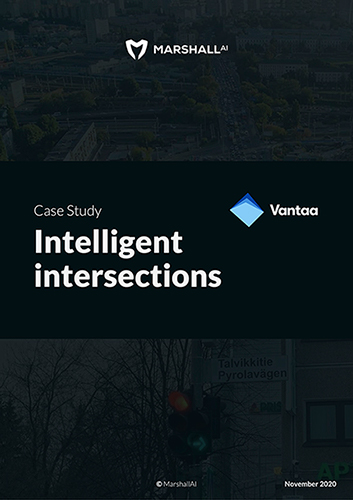MarshallAI revolutionising traffic management
MarshallAI has developed a unique traffic management solution that utilises automatic image analysis and dynamic traffic light control to make travel faster, safer and more ecological. Using brand new machine vision technology we are able to direct traffic in real-time by identifying approaching objects, as opposed to decades old static traffic control systems that are not able to react to the number, type or speed of approaching vehicles and people.


The technology is currently being tested in cities of Helsinki, Vantaa and Stockholm. In Vantaa we set up lightweight cameras at two intersections to analyse the feed in real-time and we can now share the initial results from the first stage of testing. The live feed is also available online at https://bit.ly/vantaanliikenne for anyone to see the object identification process in action.
The trial in Vantaa aimed to assess how machine vision can help reduce waiting times and emissions and to collect data about potential savings and reliability of the technology. We collected information that can be directly utilised in existing traffic control systems using cloud computing, wireless technology and secure telecommunications.
Overall the experiment showed that using MarshallAI machine vision could offer considerable improvements to the flow of traffic by reducing waiting times and unnecessary stops. The report found that objects could be identified with up to 99,8% accuracy and that waiting time at traffic lights could be reduced substantially with over 30 000 unnecessary stops avoided on an annual basis.
The study also found that smart traffic control could help cities reach their environmental goals and that safety would be improved by utilising real-time data of approaching vehicles and pedestrians. Additionally the technology has potential to be employed to collect data of traffic violations and tweaked accordingly if problems occur.
Room for further improvement was identified when challenging weather conditions, such as direct sunlight, fog or heavy snowfall, caused reduced visibility. To solve the problem we propose paying closer attention to the positioning of the cameras, incorporating heated and sunlight filtering lenses to cameras in challenging places.
MarshallAI will continue testing the image analysis technology in real life situations in the near future and we’ll make sure to keep you up to date on any exciting developments through our social media channels.

Download case study
To read about the Vantaa experiment in more detail you can download the full case study here.
Find out more about our solutions for smart cities: https://marshallai.com/smart-city/
